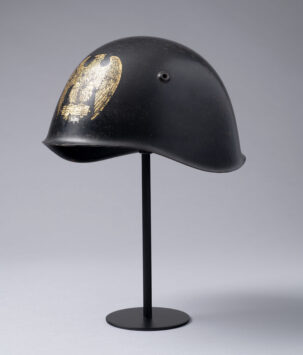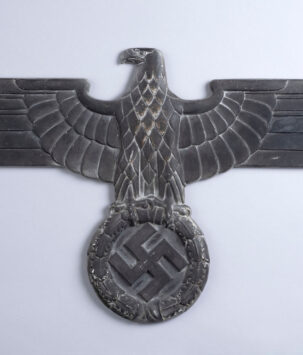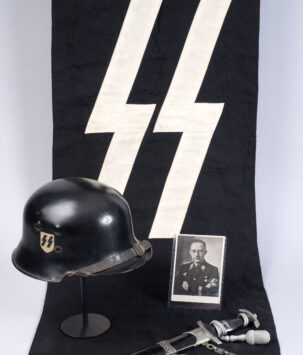Showing 37–48 of 53 results
-
A poster promoting the collaborationist Légion des volontaires français (LVF). The LVF was a military unit composed of Frenchmen who fought for the German Wehrmacht during the Second World War, ostensibly to defend Europe against Bolshevism. It was later redesignated the Waffen-SS “Charlemagne” Brigade named after the legendary medieval Frankish King Charlemagne. The LVF originated as an independent initiative by a coalition of far-right factions in Vichy France who were disillusioned with the liberalism of the Third Republic.
The Charlemagne Brigade distinguished itself in the Battle of Berlin in 1945, where it remained as one of the last active defenders in the area of Hitler’s Führerbunker complex in a powerful demonstration of chivalric gallantry befitting of their namesake.
-
The Milizia Volontaria per la Sicurezza Nazionale (MVSN), commonly referred to as the Blackshirts, was the main paramilitary wing of the National Fascist Party. They were the Italian equivalent of the German Schutzstaffel (SS) after which the latter was based upon. Surmounted on the chain is an “M” standing for Mussolini and an eagle clutching the letters “SPQR”, an abbreviation for the Roman Empire which the Italian fascists sought to emulate. The centrality of ancient Rome’s role within the palingenetic mythos of Italian Fascism cannot be understated.
-
An Italian M33 helmet for a general of the Milizia Volontaria per la Sicurezza Nazionale (MVSN), commonly referred to as the Blackshirts. The MVSN was the main paramilitary wing of the National Fascist Party, and the Italian equivalent of the German Schutzstaffel (SS) after which the latter was modeled upon.
-
The gilded Parteiadler which once adorned the very entrance to Adolf Hitler’s private living quarters in the Old Reich Chancellery. It is believed that there were only twelve such wall-mounted eagles, with examples today thought to only exist in the Imperial War Museum and Moscow’s Museum of the Great Patriotic War.
-
Eagle pulled off a locomotive of the Deutsche Reichsbahn, Nazi Germany’s state-owned railway enterprise. Originally in silver aluminum, these eagles began being coated in matte-black towards the end of the war as anti-aerial camouflage as German air superiority waned. The resulting appearance is a rather menacing and ominous one compared to its early-war silver counterpart. This aesthetic transition is reflective of the regime’s inward repression that only heightened as the war situation continued to deteriorate.
-
Postcard commemorating successive Japanese victories in the Pacific. The Imperial Japanese Navy is personified here as a mighty samurai. The subsequent fall of British Malaya and Singapore to the Japanese was described as “the worst disaster and largest capitulation in British history” by Prime Minister Winston Churchill. Backed by the three flags of the main Axis powers, it highlights the supremacy and solidarity of the fascist triumvirate as they continued to enjoy victory on all fronts.
-
Japanese soldiers during the Second World War garnered a reputation for their ferocity and unrelenting spirit in the face of countless unfavorable engagements. This was undoubtedly due to Japan’s stoic military culture. The Imperial Japanese Army (IJA), despite being a modern military force, was built on the feudal concept of Bushido, the moral code of the ancient samurai in which honor surmounted all else. In order to instill this warrior spirit in their soldiers and cement their ancestral link to the fearsome warriors of yore, the Japanese High Command endowed upon all their officers a traditional Japanese katana.
-
Army recruitment poster from the Independent State of Croatia. The leader Ante Pavelić can be seen at the forefront saluting his fascist legions with an address to the nation.
-
Spanish poster depicting a triumphant Falangist soldier standing atop a bloodied Marxist beast. The Falange Española (Spanish Phalanx) is a fascist political organization founded by José Antonio Primo de Rivera, taking its name from the heavy infantry formations of ancient Greece. It promoted the revival of the Spanish Empire, called for a national syndicalist economy and partook in the Spanish Civil War.
-
The Schutzstaffel (SS) was the Third Reich’s preeminent elite paramilitary organization, driven by its fanatical devotion to National Socialism underpinned by a nexus of esoteric, occult and mystical principles. This grouping consists of a black M34 helmet, chained dagger and autographed portrait of Reichsfuhrer-SS Heinrich Himmler, all laid upon the backdrop of a period SS banner.
-
Solid bronze desk eagle with outspread wings, head turned to its right. Refined and impactful presentation. Wingspan of 49cm and on a black stone base.
-
Japan was the only nation in the Second World War to employ biochemical warfare as part of its official military doctrine, resulting in a ghoulish aesthetic unique to the Sino-Japanese front.











